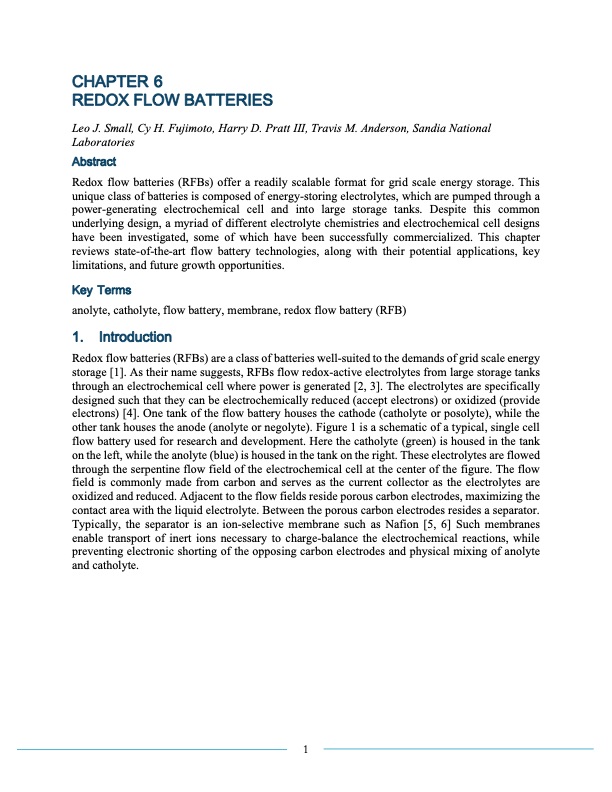
PDF Publication Title:
Text from PDF Page: 001
CHAPTER 6 REDOX FLOW BATTERIES Leo J. Small, Cy H. Fujimoto, Harry D. Pratt III, Travis M. Anderson, Sandia National Laboratories Abstract Redox flow batteries (RFBs) offer a readily scalable format for grid scale energy storage. This unique class of batteries is composed of energy-storing electrolytes, which are pumped through a power-generating electrochemical cell and into large storage tanks. Despite this common underlying design, a myriad of different electrolyte chemistries and electrochemical cell designs have been investigated, some of which have been successfully commercialized. This chapter reviews state-of-the-art flow battery technologies, along with their potential applications, key limitations, and future growth opportunities. Key Terms anolyte, catholyte, flow battery, membrane, redox flow battery (RFB) 1. Introduction Redox flow batteries (RFBs) are a class of batteries well-suited to the demands of grid scale energy storage [1]. As their name suggests, RFBs flow redox-active electrolytes from large storage tanks through an electrochemical cell where power is generated [2, 3]. The electrolytes are specifically designed such that they can be electrochemically reduced (accept electrons) or oxidized (provide electrons) [4]. One tank of the flow battery houses the cathode (catholyte or posolyte), while the other tank houses the anode (anolyte or negolyte). Figure 1 is a schematic of a typical, single cell flow battery used for research and development. Here the catholyte (green) is housed in the tank on the left, while the anolyte (blue) is housed in the tank on the right. These electrolytes are flowed through the serpentine flow field of the electrochemical cell at the center of the figure. The flow field is commonly made from carbon and serves as the current collector as the electrolytes are oxidized and reduced. Adjacent to the flow fields reside porous carbon electrodes, maximizing the contact area with the liquid electrolyte. Between the porous carbon electrodes resides a separator. Typically, the separator is an ion-selective membrane such as Nafion [5, 6] Such membranes enable transport of inert ions necessary to charge-balance the electrochemical reactions, while preventing electronic shorting of the opposing carbon electrodes and physical mixing of anolyte and catholyte. 1PDF Image | REDOX FLOW BATTERIES Chapter 6

PDF Search Title:
REDOX FLOW BATTERIES Chapter 6Original File Name Searched:
ESHB_Ch6_RedoxFlow_Small.pdfDIY PDF Search: Google It | Yahoo | Bing
Salgenx Redox Flow Battery Technology: Salt water flow battery technology with low cost and great energy density that can be used for power storage and thermal storage. Let us de-risk your production using our license. Our aqueous flow battery is less cost than Tesla Megapack and available faster. Redox flow battery. No membrane needed like with Vanadium, or Bromine. Salgenx flow battery
| CONTACT TEL: 608-238-6001 Email: greg@salgenx.com | RSS | AMP |